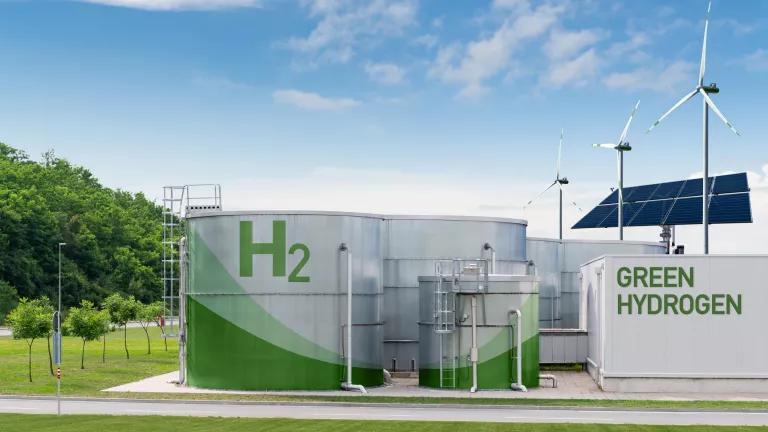IRA Clean Hydrogen Tax Credit: Debunking Five Myths
New evidence is in: The case for the three pillars is ironclad.

Four new resources were published recently that lock in the ironclad case for the Biden administration to issue rigorous guidance for the implementation of the IRA 45V clean hydrogen tax credit (PTC) and require the now familiar three pillars of 1) new supply (aka additionality), 2) deliverability, and 3) hourly matching:
- an NRDC-Clean Air Task Force (CATF) legal analysis which conclusively finds that the three pillars are legally necessary;
- an Energy Innovation study which concludes that the three pillars can unlock robust scale for the industry and that “dead on arrival” claims are false;
- a Princeton ZERO Lab white paper and cost-evaluation tool which cuts through the noise of the pile of studies on the topic and definitively finds that all studies support the conclusion that three-pillar compliant projects can be cost-competitive from day one; and
- a report by the MIT Energy Initiative finding that only hourly matching can enable emissions rates compliant with the 45V requirements, and hourly-matched hydrogen production can be produced for less than the 45V subsidy, giving an overall cost of less than $0/kg.
In contrast, a letter was sent to federal agencies by some corporates – including utilities, oil and gas majors, developers and chemical companies -- in an effort to water down the rules to maximize corporate profits -- emissions and clean hydrogen industry credibility be damned.

The 45V tax credits offer huge, uncapped incentives for “clean” hydrogen that could run up to more than $100bn. Treasury is set to issue guidance by summer to determine how lifecycle GHGs of hydrogen projects should be accounted for and determine their eligibility for the credit. Weak guidance could result in subsidizing hydrogen projects that have more than twice the emissions of today’s status quo hydrogen and drive increased emissions of more than 100 million tons of carbon dioxide in this decade. This would send us further off course from our climate goals, drive up air pollution and electricity prices, and tarnish the reputation of the nascent clean hydrogen industry that we need to decarbonize critical sectors like steelmaking.

Carbon intensity of today’s status quo gas-derived hydrogen compared to electrolysis powered by the average U.S. grid
Considering the high risks, it is extremely important for Treasury – in collaboration with the White House, Department of Energy and Environmental Protection Agency—to get it right and require rigorous rules for GHG emissions accounting that require the three pillars.
But some groups and companies are arguing that the pillars are either infeasible or too costly to implement and would kill the “clean” hydrogen industry in the crib; some further argue that we should accept emissions increases in the near-term by adopting lax rules today in order to rapidly scale the “clean” hydrogen industry and unlock emissions increases down the road.
Those arguments are grounded in myths and misguided assessments. Let’s set the record straight:
Quick recap—new clean supply, hourly matching and deliverability are necessary to guard against significant emissions increases.
A wide range of research—including new analysis by our colleagues at Energy Innovation—has consistently shown that three pillars are necessary to ensure that electrolytic hydrogen production is truly zero or very low emissions (refer to this blog, our letter to the Biden administration and NRDC’s guest spot on Volts). Even a recent study by the Rhodium Group that erroneously argues that tight tax credit rules would be too costly at first concedes that absent the three pillars, emissions from hydrogen production would increase by more than 100 million tons between 2023 and 2030, the equivalent of the entirety of North Carolina’s annual power sector emissions. Claims in the corporate letter that much looser rules— notably, annual matching in lieu of hourly matching—would not drive increased emissions are simply false.
Myth #1: Treasury has neither the legal authority nor the legal obligation to enforce the three pillars.
False. Treasury has broad authority to require the three pillars, and they are legally necessary to meet the IRA’s requirements. Loose annual matching is not consistent with the statute, as claimed by some.
The IRA gives Treasury broad authority to issue regulations for calculating the lifecycle GHG emissions of hydrogen projects. Using this broad authority, Treasury may adopt a lifecycle analysis methodology that incorporates the three pillars of new clean supply, deliverability, and hourly matching. Indeed, Congress authorized Treasury to adopt any tool—either the GREET model or a “successor model” --that accurately measures lifecycle GHG emissions.
And as we explain in our legal analysis, the three pillars are legally necessary. The IRA defines a hydrogen project’s lifecycle emissions by referencing section 211(o)(H)(1) of the Clean Air Act, which effectively requires Treasury to account for induced grid emissions related to hydrogen production. For example, if a hydrogen project connects to an existing nuclear plant, via the grid or a direct connection (i.e., “behind the meter”), nuclear power is diverted away from the grid, driving up fossil fuel generation to meet some of the gap. Treasury’s analysis must account for the emissions linked to this reshuffling.
Under this accounting system, it would be near-impossible for hydrogen projects that do not satisfy new clean supply, deliverability, and hourly matching requirements to meet the very low 0.45 kgCO2/kgH2 threshold to qualify for the top credit. In other words, a hydrogen producer that does not adopt the three pillars cannot comply with the emission thresholds outlined in the IRA. Therefore, section 45V is only workable—and its emission thresholds are only meaningful—if Treasury implements the three pillars for all projects—both grid-connected and behind-the-meter.
Myth #2: Meeting the three pillars is too costly and will kill the clean hydrogen industry in the crib.
False. Hydrogen projects that comply with the 3 pillars can be cost-competitive from day one. There is no tradeoff between scaling up the industry and safeguarding against emissions increases.
First, a range of projects already under development in the U.S. and worldwide comply with the 3 pillars.
Otherwise, the new white paper and nifty summary tool by Princeton’s ZERO lab have definitively settled the cost debate: it highlights 5 recent studies – conducted by academics, research groups, a foremost electrolyzer manufacturer, and two renewable energy developers—all of which conclude that projects can be competitive from day one while meeting the three pillars and that there is no tradeoff between scaling the industry and increasing emissions and flouting the IRA requirements (a tradeoff that some keep positing). Let’s unpack.
Electrolyzers do not need to run 24/7 to pencil out. Instead, they need to run somewhere between 50-70% on average. This is because electricity costs are the largest cost component for electrolyzers; at a certain threshold of high utilization, projects start running into expensive peak or near-peak electricity costs and the advantage of higher utilization diminishes.
There are several regions in the U.S. where a combination of wind and solar would enable electrolyzers that comply with the 3 pillars to hit that optimal utilization level and more. The 5 studies highlighted in the Princeton white paper find that when electrolyzers contract with oversized wind and solar projects, they can be very competitive from the outset with the $3/kg subsidy. For example, the new Energy Innovation study—included in the Princeton summary tool—demonstrates this dynamic (map below). And if global electrolyzer deployment is as rapid as many predict, then capital costs for electrolyzers will fall quickly in this next decade greatly expanding U.S. geographies where 3 pillar-compliant projects can be cost-competitive.

Energy Innovation map showing U.S. locations where wind and solar prices average $25/MWh or less, and where three-pillar compliant projects may be financially viable from day one.
Energy Innovation
The Princeton tool also demonstrates that the handful of studies finding that the three pillars are too costly—and which the new corporate letter invokes—rely on outlier and unreasonable assumptions about energy cost and electrolyzer utilization. When corrected, even those studies support the conclusion that three-pillar compliant projects can be cost-competitive from day one.
Myth #3: Hourly matching is too complicated and not ready for widespread deployment.
False. Hourly matching is already a reality, and can be done today across the U.S.
Hourly tracking of clean energy consumption is not new. And to quote our colleagues at EnergyTag, it is certainly not rocket science. Hourly consumption of electricity and hourly generation of clean electricity are already measured and metered. All we need is a credit to verify that they match up.
Hourly matching is already happening across the US and the world, for example for consumers like Google who want to verify that they are consuming clean power 24/7. M-RETS, a non-profit registry platform, have been tracking hourly Renewable Energy Certificates (RECS) since 2019 and have over 170 million hourly RECs in their system. M-RETs alongside groups like Flexidao and Cleartrace can deliver hourly tracking across the entire US today. PJM, the largest regional transmission operator covering much of the Mid Atlantic and Midwest, recently introduced hourly RECS, driven by increased demand from customers.

Availability of hourly matching in the U.S. today
In fact, demand for hourly matching is a broader trend among corporate customers (check out this great David Roberts series on 24/7) and the clean electricity market is moving in an hourly matching direction. It would be backwards for hydrogen to move in an antiquated direction by adopting looser matching regimes, e.g., annual matching.
Some have also argued that hourly matching is infeasible in the near-term given that there is no nationwide hourly matching standard. Of course, they fail to specify that there is no nationwide standard for the much looser “annual” matching either. Regardless of where Treasury lands, nationwide harmonization of standards could be completed on a quick timeline, in time for large scale electrolyzer deployment (which will take no less than 2 years).
Myth #4: If the three pillars are required for hydrogen production, they should be required for other technologies like EVs and heat pumps.
False. Hydrogen can increase overall emissions, while EVs and heat pumps do not. They should be—and ARE—subject to different rules because they have very different risks.
Opponents of three pillars often bemoan that hydrogen is being singled out and that to the extent the three pillars are required, they should be required for other technologies including EVs and heat pumps. The idea that we should arbitrarily and clumsily lump all IRA technologies together under the same policy needs is misguided and ignores the simple facts at play.
Hydrogen, EVs and heat pumps are very different technologies with very different impacts and risks. EVs and heat pumps are far more efficient than their fossil fuel incumbents, and will begin reducing net emissions as soon as they are plugged in. Even when EVs and heat pumps are charged from a dirty grid, they are always cleaner than internal combustion engines and gas boilers. Hydrogen on the other hand, has a rockier road to decarbonization, and needs tighter guardrails to keep it from falling over the edge. Hydrogen powered by today’s average U.S. grid or a gas plant has 2x the emissions of status quo gas-derived hydrogen; if powered by a coal plant, it has 4x the emissions of status quo gas-derived hydrogen.
This is precisely why Congress set strict emissions limits on hydrogen production in the IRA and did not set limits on say, how every charging station should be charged.
Myth #5: It’s OK for hydrogen production to increase emissions because this very dirty hydrogen will replace fossil fuels in end uses for a net positive overall.
False. Dirty hydrogen will significantly increase overall emissions in this decade.
Opponents argue that it’s OK for hydrogen production to increase emissions because this very dirty hydrogen will replace fossil fuels in end uses for a net positive overall. False. Hydrogen’s best applications—where indeed, it may reduce emissions even if powered by dirty power (mainly steel manufacturing) are not widely commercial yet and will unlikely be so before the 2030s (though opponents conveniently invoke those end-uses as applicable today). We cannot simply shrug this off, but must design rules with hydrogen’s commercially ready applications in mind—those include replacing status quo hydrogen in existing applications, blending some hydrogen in gas plants, or worse, blending in gas distribution networks. If hydrogen is produced with high emissions and replaces fossil fuels in those applications, overall emissions will still be very high (graph below).

Comparison of production emissions from hydrogen with potential emissions abatement from hydrogen use
The case for the three pillars is ironclad.
The picture has snapped into focus. The three pillars:
- Are legally necessary to meet the IRA’s statutory requirements.
- Will support robust and durable scale for the clean hydrogen industry; and
- Are the only system that will guard against emissions increases and amplified public opposition to hydrogen deployment.
The Biden administration should be confident about requiring the three pillars, and thereby setting off the clean hydrogen industry on a course to fulfill its most promising potential.




